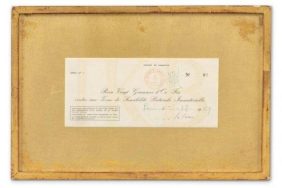Artwork: Installation photograph of Yves Klein of the Tate Liberpool’s Instagram.
Born in Nice to a pair of painters, Yves Klein (1928-1962) discovered his destiny on a beach in the south of France at the age of nineteen. He and his friends divided the world into earth, words, and space. Klein chose to rule the ethereal realm that surrounds the planet, signing his name in the air.
Also: Secret Histories | “Impasse Ronsin” Holds the Key to the Creative Genius of Modern Art
From this moment forth, he ruled the air, the skies, and all that is invisible to us embracing painting, sculpture, performance, theater, music, film, and architecture with a wholly singular approach. For fifteen years, Klein held the art world captive with his fresh, bold jaunts into worlds no one had dared to go before. Then, at the tender age of 34, he died of a heart attack leaving a legacy that has changed the world.

Yves Klein, 1928-1962. Untitled Anthropometry, (ANT 84) 1960. Dry pigment and synthetic resin on paper mounted on canvas1550 x 3590 mm © Yves Klein, ADAGP, Paris / DACS, London, 2016
Tate Liverpool presents Yves Klein, the UK’s first museum solo exhibition in more than 20 years, on view now through March 5, 2017. Featuring around 40 major works from his pivotal career, the exhibition shines fresh light on Klein’s innovative approaches to art making.
Among the works featured are his seminal monochrome, Untitled blue monochrome, (IKB 79) from 1959, a work that invokes the words of Leonardo da Vinci: “Simplicity is the ultimate sophistication.” This extraordinary use of ultramarine blue brings us back to his day on the beach when fate called to him. Here Klein introduces us to the depthless sense of space on the surface of the work, capturing a infinity of the visual world paralleled by space itself.

Yves Klein, 1928-1962 Untitled blue monochrome, (IKB 79) 1959. Paint on canvas on plywood 1397 x 1197 x 32 mm. © Yves Klein, ADAGP, Paris and DACS, London 2016.
In Yves Klein, 1928 – 1962, Selected Writings, (Tate Gallery, 1974), the artist revealed, “My monochrome pictures are not my definite works, but the preparation for my works. They are the leftovers from the creative processes, the ashes. My pictures, after all, are only the title-deeds to my property which I have to produce when I am asked to prove that I am a proprietor.”
Klein’s otherworldly sense of freedom is apparent in his playful Anthropometry paintings, which he created by choreographing nude models as living paint brushes to transfer blue pigment onto canvas. Truly a progenitor to Pop and Performance Art, Klein introduced the element of risk with his pyrotechnic Fire Paintings, created using a flamethrower.

Yves Klein, 1928-1962.Untitled Fire painting, (F 101) 1961. Burned paper mounted on cardboard. 625 x 520 mm © Yves Klein, ADAGP, Paris / DACS, London, 2016. Photo © Museum moderner Kunst Stiftung Ludwig Wien
Klein explained, “I made the flames lick the surface of the painting in such a way that is recorded the spontaneous traces of the fire. But what is it that provokes in me this pursuit of the impression of fire? Why must I search for its traces? Because every work of creation, quite apart from its cosmic position, is the representation of pure phenomenology—every phenomenon manifests itself of its own accord. This manifestation is always distinct from form, and is the essence of the immediate, the trace of the immediate.”
The immediate, which cannot be denied, is what makes Klein’s work so influential and so fresh so many decades after it was born. But perhaps nothing is quite so magnificent as “Leap Into the Void,” his collaboration 1960 with Harry Shunk and János Kender. Here he takes flight, eternally, forever embodying his position as fearless ruler of the atmosphere.

Harry Shunk, 1924-2006 and János Kender, 1938–2009. Yves Klein’s “Leap Into the Void,” Fontenay-aux Roses, France, 1960 October 23 1960. Harry Shunk and Shunk-Kender photographs. Artistic action by Yves Klein © Yves Klein, ADAGP, Paris and DACS, London 2016. Collaboration Harry Shunk and János Kender © J. Paul Getty Trust. Getty Research Institute, Los Angeles (2014.R.20)
Miss Rosen is a New York-based writer, curator, and brand strategist. There is nothing she adores so much as photography and books. A small part of her wishes she had a proper library, like in the game of Clue. Then she could blaze and write soliloquies to her in and out of print loves.



